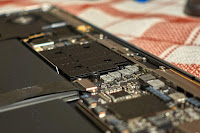MacBook Air (early 2020) configuration: i7/16GB/1TB
TL;DR: Sealing up the wind channel appears to only offer limited performance improvements.
Date of original mod: 29 April 2020
MacRumors: Post 966
Background
Soon after the 2020 MacBook Air was released, it was soon discovered that the thermal design of the processor heat sink appeared to be suboptimal. In fact, this discovery was first made when srkirt, a MacRumors forum poster, took the heat sink off his 2019 MacBook Air processor and found that the heat sink does not directly on top of the processor. Instead, there is a sub-millimetre gap that is filled by a dark, thick, gritty thermal paste. This started a series of experiments in improving the thermal performance of the 2020 MacBook Air.Below are some photos of the innards of the MacBook Air. The heat sink looks somewhat like corrugated cardboard but in metal form. The foam pad that is stuck to the inside of the bottom case seems to be there to press against the heat sink so that all the air is forced to go through the heat sink.
Note: bottom case screws are Pentalobe 5 (P5).
Wind Channel Modification
My first modification was to see if thermal performance could be improved by focussing the air to pass over the heat sink. By sealing the area between the fan and heat sink, the hope was that this will force the fan to draw all its air from behind the heat sink, thus maximising airflow through the heat sink for hopefully higher cooling effect.For a lack of appropriate materials, I cut strips of corrugated cardboard and lined them against the metal separators that are next to the batteries (indicated by red boxes below). I found that performance was worse when the cardboard strips were taller than the metal separators, compared to them being the same height. I think this was because the cardboard would push bottom case out and create gaps in the wind channel. Corrugated cardboard turned out to be quite good because it has the thickness to hold itself in place and can easily be made narrower when needed.
Results
I used Intel Power Gadget (v3.7.0) to monitor the temperature and CPU/GPU frequencies, and used its built-in tests to load the CPU (All Thread Frequency) and GPU (Maximum Frequency). I let each test run until the frequency stabilised, and then maxed out the fans to test the full wind channel effect. I then let the frequency stabilise again (usually goes up). My MacBook Air was fully charged and plugged in, and the screen was set to maximum brightness and always on.I ran the tests before and after the mod, and back-to-back to minimise differences in ambient temperature. What I saw was that the wind channel mod had a very slight effect on CPU (+70 MHz at best) and GPU (+30 MHz) performance. I forgot to take a screenshot of the original GPU performance. The temperatures around the case appear to be normal, so the wind channel modification doesn't seem to have an adverse effect on other components.
The question now is whether this slightly improved wind channel in combination with a heat sink modification translates to higher performance.












0 comments:
Post a Comment